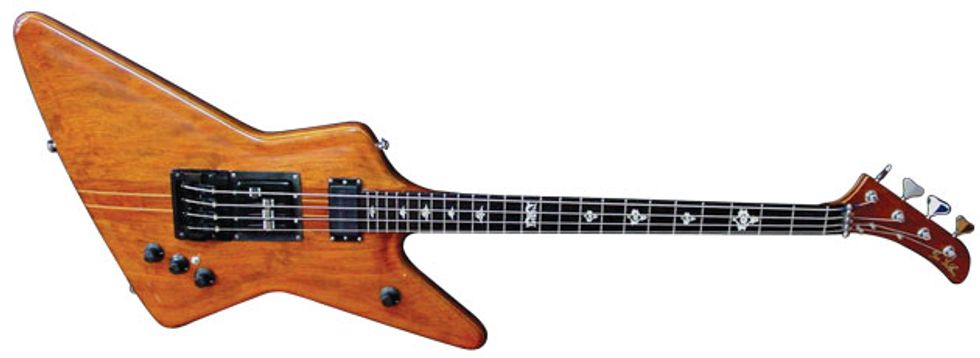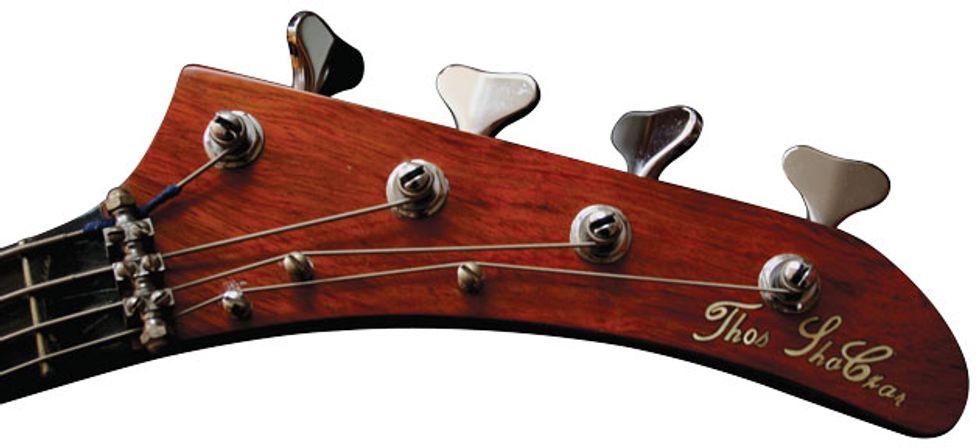Fig. 1. Tom Lieber built this prototype Explorer bass for John Entwistle around 1981. Photo courtesy of Tom Lieber (lieberguitars.com)
Have you ever wondered why some of your instruments go out of tune faster than others, even though you can’t identify a specific reason why? Tuning instability is a much bigger problem for guitarists than bassists, yet because modern bass players are often asked to do more than just keep the groove, tuning and intonation have become important issues for low-enders too. Playing an extended-range bass, doing solos, or even just covering a wider frequency spectrum requires you to stay in tune if you want to keep your gig. Naturally, many bassists who wrestle with this problem assume their tuners are the source of any instability and immediately swap the machine heads as a way to combat it. There are several things you can do to avoid tuning instability, but it’s rarely the tuner that’s causing the problem.
To get an idea of what could be the cause, it makes sense to look at the problem the other way around:
If you were to design the bass with the most stable tuning of all time, how would you begin? First, you’d get the shortest possible active string length. By active, I mean everything that is under tension. Remember, you can’t stretch what’s not there. The minimum would be the scale length plus all space needed for either tuning or intonation adjustment. The tuner could be a locking version, reducing the string-length on the axis, but even better yet would be a linear and non-winding tuner.
You’d also need to have two saddle points for each string and both should be very slippery to equal out any differences in tension along the string. A solid, stiff body won’t have much effect, but you might want to add some lacquer to save the body from moisture changes. Same thing for the neck, which is much weaker and these days is often combined with reinforcing layers of carbon. Lastly, you could eliminate all temperature- and moisture-sensitive material. Voilà—you’ve just designed your first headless bass in the classic Steinberger style!
Now, given that the majority of bass players tend to own Fender-style basses, it makes sense to look at the differences between those and our hypothetical design. We want to know how these differences potentially affect tuning stability. The most obvious difference is the headstock, which adds roughly 15 percent additional active string length. It can’t be as stable as the shorter headless, but 15 percent sounds like something one can live with. Still, there are typically two other parts on a headstock that have way more influence on tuning stability: the nut and one or more string trees. Both add friction to the strings, hindering them from equaling out different tensions.
You can test this yourself by bending a string. If it’s flat after the bend, then there’s too much friction. Raising the string tree by loosening its screw will reduce the friction at both the tree and nut. Then if you can confirm that each nut slot is wide enough not to bind the string, there isn’t much more you can do, except lubricate the slots. You have many options for this task, including gun oil, pencil graphite, or Vaseline. The differences between these lubricants won’t be huge, so use what you have at hand, but be sure to apply it regularly. It doesn’t hurt to lubricate the bridge saddles at the point where the string contacts them, but saddles rarely cause problems.
Fig. 2. Lieber used rollers to adjust string alignment on the zero fret and also create the necessary downward pressure to hold the strings against it. Entwistle’s preferred headstock shape requires additional hardware to guide the strings into their respective tuners. Photo courtesy of Tom Lieber (lieberguitars.com)
Of course, different nut materials have different frictions. Graphite is the slipperiest nut material, and because installing a graphite nut is way cheaper than replacing all the tuners, it’s well worth trying. Ball-bearing roller nuts and saddles have long been available to guitarists, but only a few exist for bass. Mark King got one on his Jaydee bass—which John Diggins built back in 1978 in Birmingham, England—but even that had just one roller for the G string. Kramer made one for their DMZ aluminum-neck basses in 1979, but they located it behind a zero fret and used the rollers to adjust the strings’ side-to-side spacing.
Another bass with a roller nut is the prototype Explorer bass built by Tom Lieber for John Entwistle around 1981 (Fig. 1). Here, the rollers are used to set string spacing across the zero fret and also create the requisite downward pressure against it (Fig. 2). As you can see, Entwistle’s preferred headstock shape compels a rather unfavorable arrangement of the tuners, and the extra hardware required to guide the strings causes additional friction—the enemy of tuning stability. It’s another example of how fashion can override the practical benefits of pure functionality.









![Rig Rundown: AFI [2025]](https://www.premierguitar.com/media-library/youtube.jpg?id=62064741&width=1245&height=700&quality=70&coordinates=0%2C0%2C0%2C0)












 Shop Scott's Rig
Shop Scott's Rig![Rig Rundown: Russian Circles’ Mike Sullivan [2025]](https://www.premierguitar.com/media-library/youtube.jpg?id=62303631&width=1245&height=700&quality=70&coordinates=0%2C0%2C0%2C0)















































